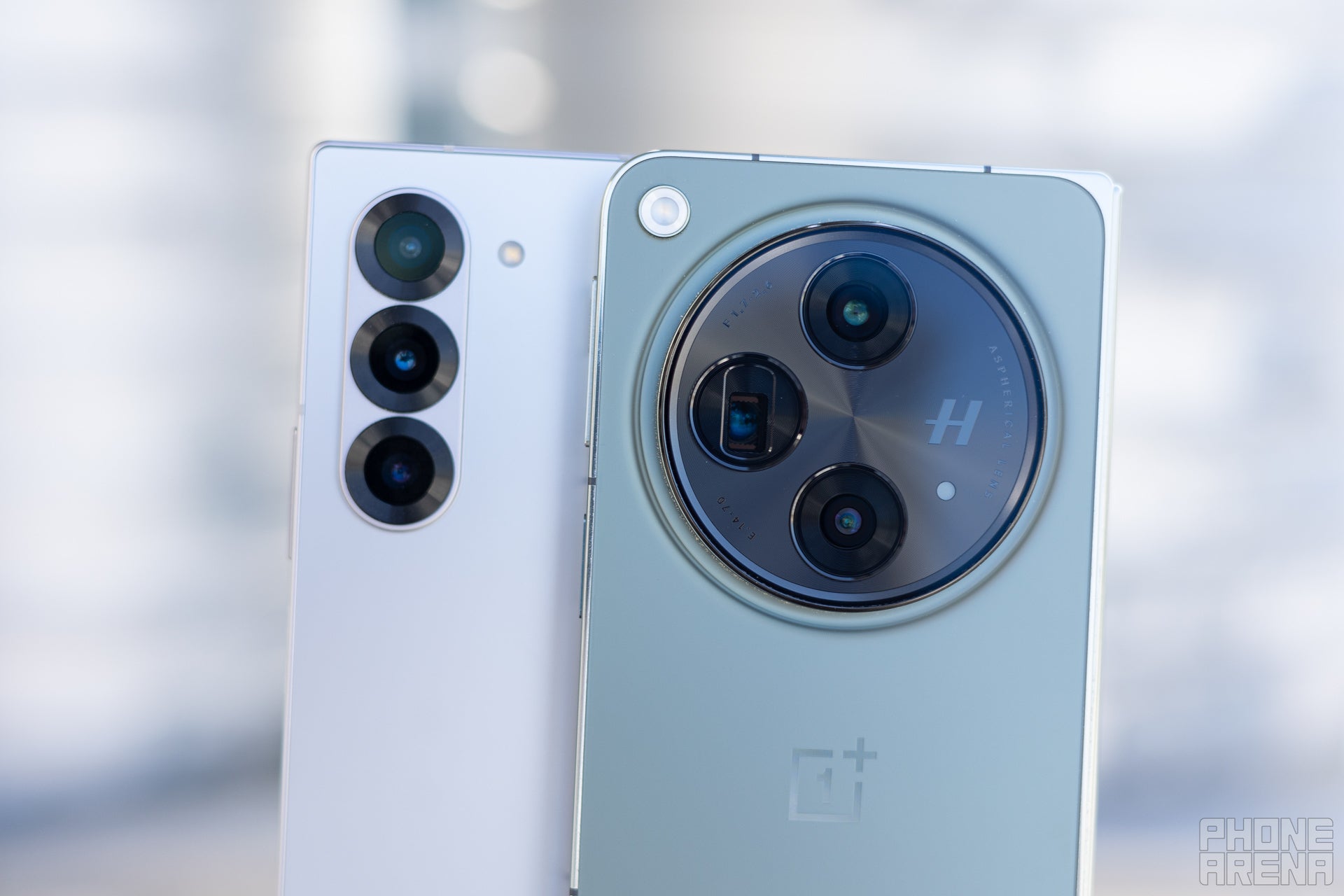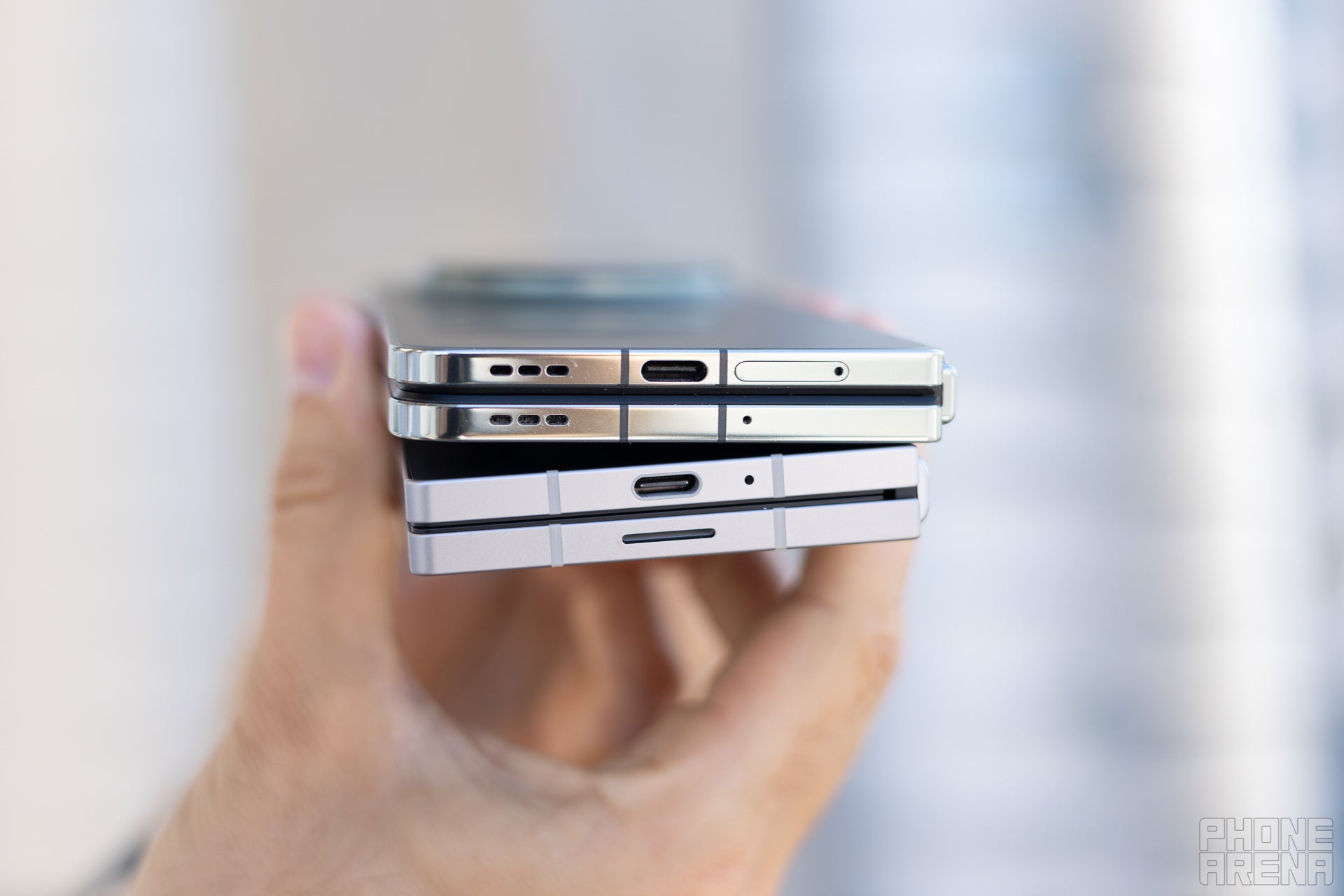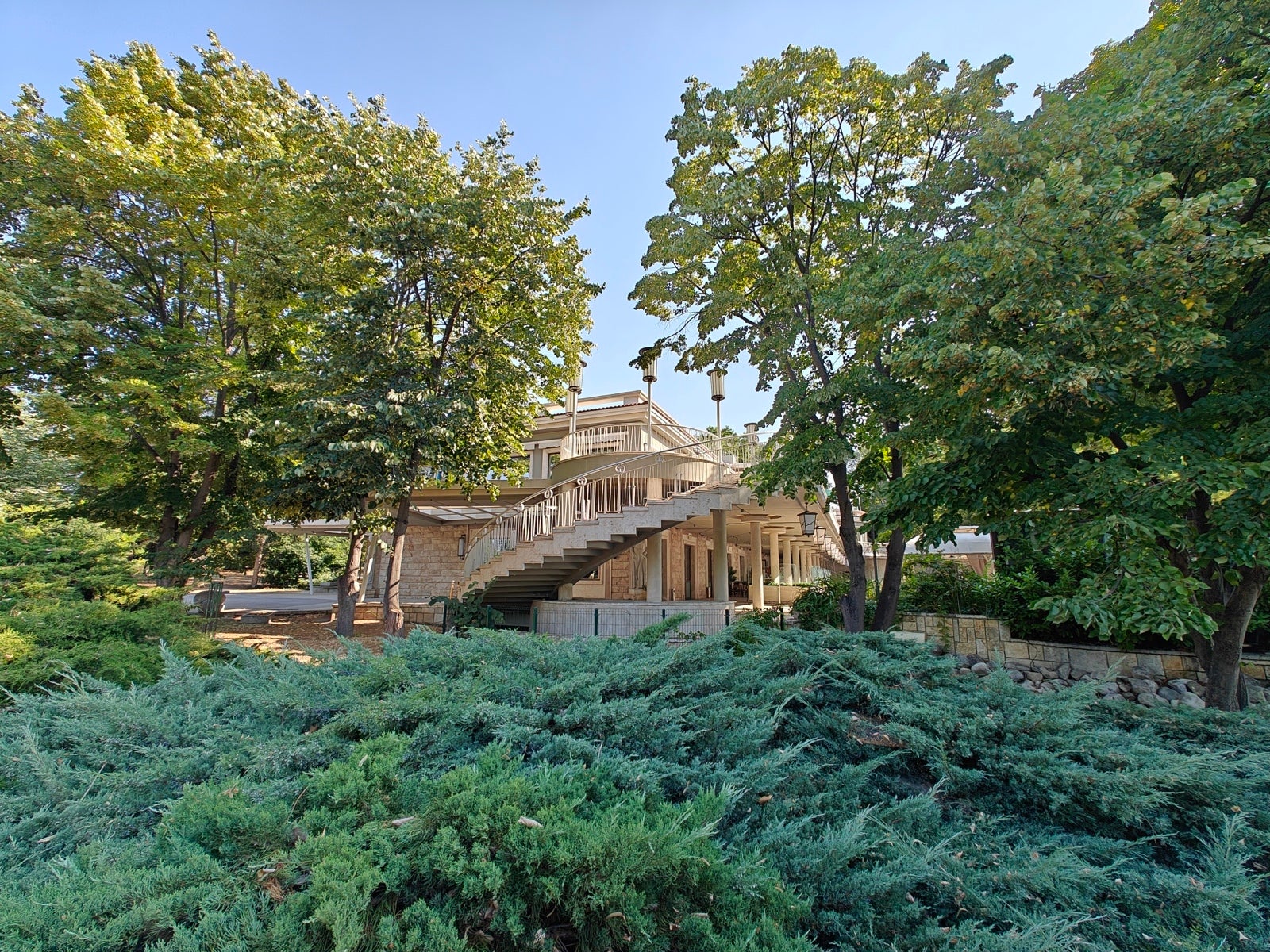Galaxy Z Fold 6 vs OnePlus Open: The foldable trend-setters
We may earn a commission if you make a purchase from the links on this page.

Intro
The Samsung Galaxy Z Fold 6 is the newest installment in the company's lengthy foldable phone roster. Now, we didn't really expect any major changes, and at the end of the day, this is precisely what we got. The Galaxy Z Fold 6 is a very safe evolutionary step that introduces slight design updates and hardware upgrades.
Meanwhile, the OnePlus Open is easily among the very best foldable phones we've seen so far, with a spectacular build and design. It also has a very capable camera, superb performance and battery life, lovely displays, and a very attractive price tag. It's a phone that got many things right from the get-go, leaving us really intrigued as to how a potential second-gen OnePlus Open could work.
Galaxy Z Fold 6 vs OnePlus Open differences:
| Galaxy Z Fold 6 | OnePlus Open |
|---|---|
| Similar design as previous Galaxy Z Fold devices | One of the best-designed foldable phones of 2023 |
| Similar camera system to the past two generations | A very powerful camera system that rivals many standard flagships |
| 12GB of RAM, 1TB of storage variant also available | Lots of RAM and native storage, but a single storage/RAM version |
| Qualcomm Snadrpagon 8 Gen 3 chip on board | A capable but older Snapdragon 8 Gen 2 chipset |
| Smaller 4,400mAh battery | A large 4,805mAh battery |
| Slower 25W charging | Super-fast 67W wired charging |
Table of Contents:
Read more:
Design and Display
Can Samsung beat OnePlus?

Who's playing catch here? (Image by PhoneArena)
With the Galaxy Z Fold 6's predecessors, Samsung finally introduced a no-gap design when folding the screen but didn't fix that display crease that runs across the display like a canyon. Sadly, despite the introduced novelties in the Galaxy Z Fold 6, there is still a visible display crease that you can easily feel when running your finger across.
Samsung's foldable still relies on Armor Aluminum (no titanium here) and uses Corning's Gorilla Glass Victus 2. Due to internal design changes, however, Samsung has achieved significant weight savings, resulting in a total weight of just 239gr, impressive for a foldable phone!
While the Galaxy Z Fold range was the first to deliver a large mainstream foldable phone, the OnePlus Open did so much right from the get-go. The OnePlus Open is a slightly heavier but very well-built foldable phone with no wedge between the bottom and top panels, as well as virtually no display crease, which makes for a very pleasing user experience.

Both phones feature excellent design (Image by PhoneArena)
Resistance-wise, the OnePlus Open is merely rated as an IPX4 device, which means it's only splash resistant and any serious contact with water might damage it. Meanwhile, the Galaxy Z Fold 6 receives an official IP48-rated phone, which means it can survive in up to 1.5m of freshwater for up to 30 minutes and it will also resist larger particles, but does not have full dust resistance.
Each of these two foldable phones have unique features of sorts. For the OnePlus Open, that's the wildly useful ring switch, a signature OnePlus quirk. At the same time, the Galaxy Z Fold 6 also supports a unique version of Samsung's S Pen, although it doesn't have a silo slot on deck.
Colors-wise, the Galaxy Z Fold 6 comes in Silver Shadow, Pink, and Navy, while Crafted Black and White are exclusively available on Samsung.com. The OnePlus Open is only available in two colors, Emerald Dusk and Voyager Black.

Screens for days (Image by PhoneArena)
The OnePlus Open remains the phone with the larger display. It has a 7.8-inch internal screen, which has a nearly perfect square aspect ratio, while the external screen measures 6.3 inches in diagonal. Both screens are AMOLED ones, with HDR support, dynamic refresh rate that goes as up to 120Hz for a super-smooth experience, and high maximum brightness.
Once again, no crease on the OnePlus Open, which is something you definitely want to see on foldable phones going forward!
At the same time, the Galaxy Z Fold 6 comes along with a 7.6-inch outer screen with a more squarish aspect ratio of 20.9:18 (as opposed to the Galaxy Z Fold 5's 22:9 one). The outer screen is a 6.3-inch AMOLED one with a 22.1:9 aspect ratio (vs 23.1:9 on the Galaxy Z Fold 5). Both panels boast a dynamic refresh rate of 1 to 120Hz, which ensures for a very smooth experience based on the on-screen content.
At the same time, the Galaxy Z Fold 6 comes along with a 7.6-inch outer screen with a more squarish aspect ratio of 20.9:18 (as opposed to the Galaxy Z Fold 5's 22:9 one). The outer screen is a 6.3-inch AMOLED one with a 22.1:9 aspect ratio (vs 23.1:9 on the Galaxy Z Fold 5). Both panels boast a dynamic refresh rate of 1 to 120Hz, which ensures for a very smooth experience based on the on-screen content.
As per our own benchmark tests, the Galaxy Z Fold 6 surpasses the OnePlus Open in terms of maximum brightness, achieving north of 1,400 nits of peak brightness. This is noticeably higher than the OnePlus Open, which hits a "measly" 1034 nits of max brightness. The minimum brightness is also superior on the Galaxy Z Fold 6, going down to just a single nit of brightness. The display of the Galaxy Z Fold 6 is more color-correct out of the box, too.
Performance and Software
Snapdragon power

Both are pretty powerful phones (Image by PhoneArena)
The Galaxy Z Fold 6 is powered by the Qualcomm Snapdragon 8 Gen 3 chip, which is currently the best one available for Android phones. This is the same chip that ticks inside the Galaxy S24 Ultra as well as the Galaxy S24 Plus and Galaxy S24 in the US.
Meanwhile, the OnePlus Open comes along with the Qualcomm Snapdragon 8 Gen 2. It was the best chipset available at the time of the OnePlus Open's arrival, and it truly helped the foldable to simply fly.
As per our own benchmarking tests, the Galaxy Z Fold 6 decidedly beats the OnePlus Open in both the CPU-heavy Geekbench 6 and the 3DMark Extreme GPU tests. Performance-wise, the new Fold is the more future-proof device.
Memory-wise, the Galaxy Z Fold 6 comes along with 12GB of RAM, as well as 256GB of base storage, but there are also 512GB and 1TB versions of the phone available. Meanwhile, the OnePlus Open can be yours in only a single version, with 16GB of RAM and 512GB of storage.
In terms of software support, the Galaxy Z Fold 6 will be supported for seven years, so until 2031. This covers both major Android upgrades as well as timely security patches. At the same time, OnePlus said it will support its foldable for four years last year, meaning it will receive major Android software updates along with security patches until 2027. Thus, the Galaxy Z Fold 6 definitely has the upper hand here.
Camera

Not all triple cameras are made equal (Image by PhoneArena)
The OnePlus Open comes along with a pretty decent camera setup. It has a 48MP main aided by a 48MP ultra-wde and a 64MP telephoto with 3X optical zoom. The main camera uses a large 1/1.43" Sony LYTIA-T808 stacked sensor. An innovative pixel layout makes this sensor capable of capturing more light and delivering far superior dynamics than the more conventional camera sensors. As far as foldable cameras come and go, the OnePlus Open is pretty capable, all things considered.
The Galaxy Z Fold 6, on the other hand, comes along with the following setup:
- 50MP primary sensor with f/1.8 aperture and OIS;
- 10MP secondary telephoto lens with f/2.4 aperture, OIS, and 3x optical zoom;
- Updated 12MP ultra-wide-angle with f/2.2 aperture and possibly better low-light performance
If that one seems familiar, that's because it is––Samsung has been reusing the same general camera setup since the Galaxy Z Fold 4. We suspect that the brunt of the possible improvements will come from the software side; we are yet to test that out.
Main camera
In broad daylight, the OnePlus Open does a better job with the overall dynamics of the scene, and also delivers superior sharpness. The photo taken with the Galaxy Z Fold 6 is slightly inferior when it comes to overall detail preservation. The color science is also quite different on both: right out of the box, the OnePlus Open delivers photos with a slightly colder temperature, whereas the Galaxy Z Fold 6 gives us pictures with a greener tint. Nothing that a filter can't fix.
At night, the OnePlus Open captures more vivid colors. However, the Galaxy does a better job with low-light dynamics; for example, the Samsung foldable does a better job at capturing details in the shadowy areas of an image.
Zoom Quality
When it comes to zoom quality at 3X, which is the native zoom level of both the Galaxy Z Fold 6 and the OnePlus Open, the latter is slightly less impressive, though it still delivers more vivid colors.
At 5X, the OnePlus Open is superior as it captures detail better, with no sign of oversharpening. However, the lively colors it captures might not be your cup of tea, as the Galaxy Z Fold 6 looks more true-to-life here.
At 10X, the OnePlus Open is the better performer once again, delivering better detail. That's all that matters at such high levels of zoom.
Ultra-wide Camera
The general differences between the two devices are visible here as well. The OnePlus Open has a slightly different color science, but the two devices are very comparable in this particular scenario. Both are excellent!
Selfie Camera
For selfies, it's the Galaxy Z Fold 6 that has the upper hand. Not only does it capture more details, it also delivers better dynamics and more realistic colors.
Audio Quality and Haptics
The OnePlus Open delivers spectacular sound, with a triple-speaker spatial setup that also supports Dolby Atmos. The phone delivers a punchy and rich sound that's a joy to listen to. Samsung has never been a slouch when it comes to audio, and the Galaxy Z Fold 6 impresses.
From a loudness and quality standpoint, it's almost on par with the Galaxy S24 Ultra, which is great to hear!
Haptics-wise, the OnePlus Open delivered magnificent haptics thanks to its new X-axis motor. The Galaxy Z Fold 6 also has a top-notch vibrator on board, bringing pleasing feedback.
Battery Life and Charging
Heated battle

The Galaxy Z Fold 6 and the OnePlus Open are dunking it out (Image by PhonArena)
Despite our expectations for a larger battery, the Galaxy Z Fold 6 arrives with a 4,400mAh battery, which is… just as much as last year's Galaxy Z Fold 5. We can probably expect slightly better battery life thanks to the more efficient chip, though. Remains to be seen.
Meanwhile, the OnePlus Open fits a large 4,805mAh battery on the inside, which delivers a surprisingly decent battery life in comparison with both foldables and candybar phones. In comparison with the Galaxy Z Fold 5, the OnePlus Open fared much, much better as far as battery life goes, so the Galaxy Z Fold 6 has a lot of ground to cover.
Our battery benchmarks reveal that the Galaxy Z Fold 6 and the OnePlus Open have pretty comparable battery endurance. In our custom web browsing test, conducted at 200 nits of display brightness, the OnePlus Open is slightly better, but the Fold isn't too far behind.
In our video streaming test, the Galaxy Z Fold 6 diminishes the lead of the OnePlus Open, which still technically lasts longer, but not by much.
Finally, in our 3D gaming test, it's the Galaxy Z Fold 6 that takes the lead, likely due to the faster and more efficient graphics unit inside the Snapdragon 8 Gen 3.
Charging-wise, it will also be rather challenging to one-up OnePlus. The latter supports super-fast 67W wired charging, which fully charges the phone in just 43 minutes. Galaxy Z Fold 6 reiterates the 25W wired charging of its predecessor, so a potential 80-minute full charge is in the cards. Fast wireless and reverse wireless charging are also on deck.
Specs Comparison
| Galaxy Z Fold 6 | OnePlus Open |
|---|---|
| Unfolded: 153.5 x 132.6 x 5.6mm Folded: 153.5 x 68.1 x 12.1mm Weight: 239gr | Unfolded: 153.4 x 143.1 x 5.8mm (Emerald Dusk) | 153.4 x 143.1 x 5.9mm (Voyager Black) Folded: 153.4 x 73.3 x 11.7mm (Emerald Dusk) | 153.4 x 73.3 x 11.9mm (Voyager Black) Weight: 245gr (Emerald Dusk) | 239gr (Voyager Black) |
| Silver Shadow, Pink, Navy (Crafted Black, White exclusive on Samsung.com) | Emerald Dusk, Voyager Black |
| Main screen: 7.6" AMOLED, HDR, 1-120Hz, 20.9:18 aspect ratio Cover screen: 6.3" AMOLED, HDR, 1-120Hz, 22.1:9 aspect ratio | Main screen: 7.82" AMOLED, 2440x2268, LTPO 3.0 (1-120Hz), sRGB, DCI-P3 Cover screen: 6.31" AMOLED, 2484x1116, LTPO 3.0 (1-120Hz), sRGB, DCI-P3 |
| Snapdragon 8 Gen 3 | Qualcomm Snapdragon 8 Gen 2, Adreno 740 |
| 12GB RAM 256GB/512GB/1TB | 16GB LPDDR5X RAM 512GB UFS 4.0 |
| One UI 6.1.1, Android 14 | OxygenOS 13.2 based on Android 13 |
| Main: 50MP primary sensor with f/1.8 aperture and OIS; Telephoto: 10MP secondary telephoto lens with f/2.4 aperture, OIS, and 3x optical zoom; Ultra-wide: 12MP, f/2.2 aperture Internal selfie camera: 4MP under-display camera, F1.8 External selfie camera: 10MP, F2.2 | Main: 48MP, f/1.7, Sony LYT-T808 1/1.43" sensor, 24mm equivalent, OIS, EIS, PDAF+CAF Ultra-wide: 48MP, f/2.2, Sony IMX581 1/2" sensor, 114-degree FOV, EIS, AF, Macro Telephoto: 64MP, f/2.6, OmniVision OV64B 1/.2" sensor, 3X optical zoom (70mm equivalent), 6X in-sensor crop, 120X maximum zoom, OIS, EIS, AF Internal selfie camera: 20MP, f/2.2, 1/4" sensor, fixed focus External selfie camera: 32MP, f/2.4, 1/3.14" sensor, fixed focus |
| 4,400mAh | 4,805mAh |
| 25W wired charging, Fast Wireless charging 2.0, no charger in the box | 67W SUPERVOOC charging (charger in box) |
Summary

Which one should you get? (Image by PhoneArena)
It's objectively true that Galaxy Z Fold phones have stagnated over the past few years, despite being the first to hit the global market with their unique foldable feature. But… there's no denying they are the most popular foldables out there, so as long as Samsung keeps making them, people will buy them, even if some of their rivals offer arguably a better experience.
The OnePlus Open is certainly one of the best foldable phones to beat right now. With a superb design, excellent cameras, top-notch performance and battery life, the OnePlus Open got so many things right from the very first try. And there's likely a second generation coming this year as well. Samsung finally has a worthy opponent in the face of the OnePlus Open and its possible successor.
The Galaxy Z Fold 6, on the other hand, doesn't overhaul the philosophy behind the Galaxy Z Fold lineup. In fact, it will most certainly go down in history as a minor upgrade. However, everything with the Galaxy Z Fold 6 just clicks and makes for a compelling product that doesn't have an inherent problem.
























![iPhone users on AT&T left without service after massive outage [UPDATED]](https://m-cdn.phonearena.com/images/article/161893-wide-two_350/iPhone-users-on-AT-T-left-without-service-after-massive-outage-UPDATED.jpg)














Things that are NOT allowed: